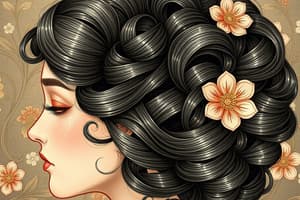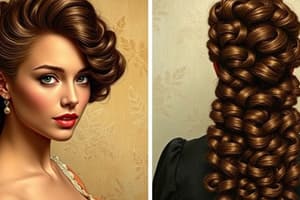Podcast
Questions and Answers
What length of hair is the spiral technique most often used on?
What length of hair is the spiral technique most often used on?
Medium to long
As added texture expands the form:
As added texture expands the form:
The illusion of shorter length is created
What are the two basic wrapping techniques for rotating strands around a perm tool?
What are the two basic wrapping techniques for rotating strands around a perm tool?
Spiral and overlap
The overlap (croquignole) technique produces which result?
The overlap (croquignole) technique produces which result?
Positioning texture in one or more specific areas or zones of the head, or along only a certain portion of the hair strand is called:
Positioning texture in one or more specific areas or zones of the head, or along only a certain portion of the hair strand is called:
You can apply the design principles of repetition, alternation, progression, and contrast:
You can apply the design principles of repetition, alternation, progression, and contrast:
Perm patterns:
Perm patterns:
Zonal perms are also called:
Zonal perms are also called:
What is the basic decision when moving from existing to desired texture?
What is the basic decision when moving from existing to desired texture?
What can a zonal perm do?
What can a zonal perm do?
Adding texture to the fringe can do what?
Adding texture to the fringe can do what?
When is base perming used?
When is base perming used?
What is end perming?
What is end perming?
Name the 5 perm patterns.
Name the 5 perm patterns.
What does the bricklay pattern help avoid?
What does the bricklay pattern help avoid?
A rectangle pattern is also known as a:
A rectangle pattern is also known as a:
In a contour pattern, the rods lay:
In a contour pattern, the rods lay:
Flashcards
Spiral technique hair length?
Spiral technique hair length?
Medium to long hair lengths.
Effect of added texture on hair length?
Effect of added texture on hair length?
It creates the illusion of shorter length by expanding the form.
Wrapping techniques for perm tools?
Wrapping techniques for perm tools?
Spiral and overlap.
Overlap (croquignole) technique result?
Overlap (croquignole) technique result?
Signup and view all the flashcards
Texture placement?
Texture placement?
Signup and view all the flashcards
Design principles apply to texture?
Design principles apply to texture?
Signup and view all the flashcards
What are Perm patterns?
What are Perm patterns?
Signup and view all the flashcards
Zonal perms are also called?
Zonal perms are also called?
Signup and view all the flashcards
Basic decision for desired texture?
Basic decision for desired texture?
Signup and view all the flashcards
What can a zonal perm do?
What can a zonal perm do?
Signup and view all the flashcards
Adding texture to the fringe can do what?
Adding texture to the fringe can do what?
Signup and view all the flashcards
When is base perming used?
When is base perming used?
Signup and view all the flashcards
What is end perming?
What is end perming?
Signup and view all the flashcards
5 perm patterns?
5 perm patterns?
Signup and view all the flashcards
Bricklay pattern helps avoid?
Bricklay pattern helps avoid?
Signup and view all the flashcards
Rectangle pattern is also known as?
Rectangle pattern is also known as?
Signup and view all the flashcards
In a contour pattern, the rods lay?
In a contour pattern, the rods lay?
Signup and view all the flashcards
Study Notes
Perm Techniques and Definitions
- The spiral technique is best utilized on medium to long hair.
- Added texture creates the illusion of shorter hair lengths.
- Two primary wrapping techniques for perming are spiral and overlap.
Wrapping Techniques and Effects
- The overlap (croquignole) technique produces undulating waves and curls.
- Texture placement refers to positioning texture in specific areas of the head or along portions of the hair strand.
Design Principles in Perming
- Design principles of repetition, alternation, progression, and contrast can be applied along the hair strand and within texture zones.
- Perm patterns, or wrapping patterns, affect the final curl appearance and assist in organizing perm services.
Types and Effects of Perms
- Zonal perms are also known as partial perms and are used to emphasize or support specific areas, as well as create bold statements.
- Adding texture to the fringe boosts volume and height in hairstyles.
Purpose of Base and End Perming
- Base perming is used for creating lift and volume, especially for new hair growth to match previously permed texture.
- End perming enhances texture away from the base, resulting in contrasting textures.
Perm Patterns Overview
- Common perm patterns include rectangle, contour, bricklay, spiral bricklay, and zonal.
- The bricklay pattern is beneficial for avoiding splits in the curling process.
- A rectangle pattern is referred to as a 6-block pattern.
- In a contour pattern, rods are positioned diagonally forward, transitioning to horizontal as they progress.
Studying That Suits You
Use AI to generate personalized quizzes and flashcards to suit your learning preferences.




